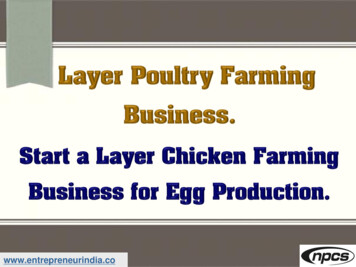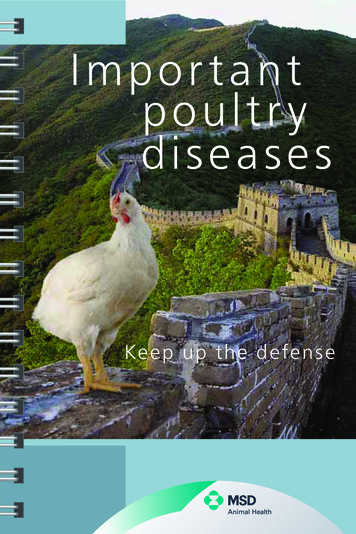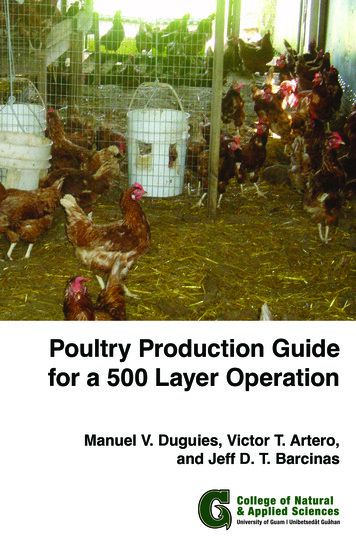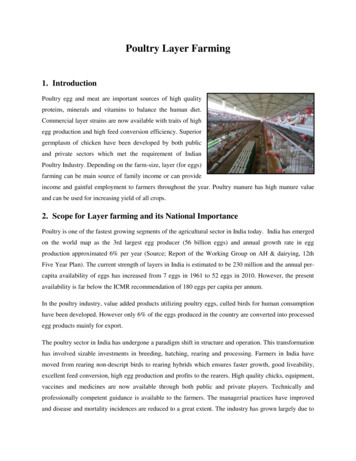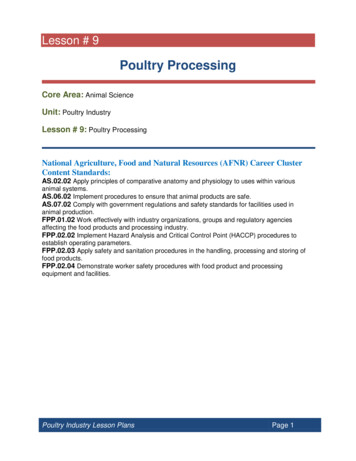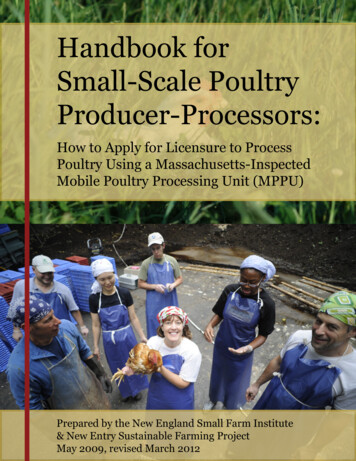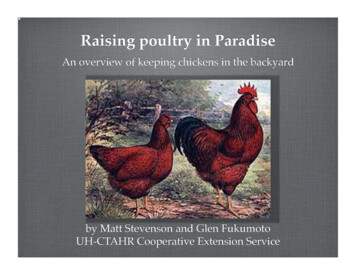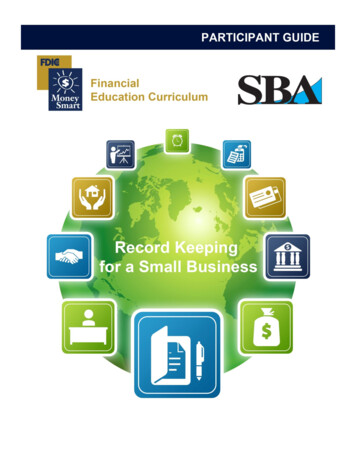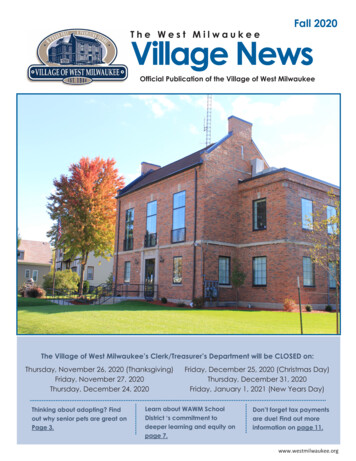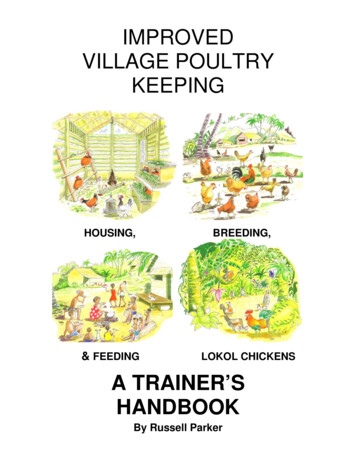
Transcription
IMPROVEDVILLAGE POULTRYKEEPINGHOUSING,& FEEDINGBREEDING,LOKOL CHICKENSA TRAINER’SHANDBOOKBy Russell Parker
IMPROVED VILLAGE POULTRY KEEPINGIMPROVED VILLAGE POULTRY KEEPINGA TRAINERS HANDBOOKBy Russell Parker 2007 Russell ParkerGraphics and IT Support:Ben ParkerRed Dingo ussell ParkerMain Artwork generously provided by:Sally Baker-BeallCover:Sally Baker-BeallSupported by GRM International and Kyeema Foundation:By Russell Parker Kai Kokorako Perma-Poultry2
IMPROVED VILLAGE POULTRY KEEPINGPREFACEThis training manual has been written for agricultural extension workers,government field officers and non-government organisations training staff.The purpose of the manual is to serve as a guide for training villagers inImproved Village Poultry Keeping so that: The peoples’ own diets and health will improve through a greaterconsumption of eggs, chicken and duck meat.The villagers can set up a poultry keeping system as a small business toraise income for school fees, household needs and a better lifestyle fortheir community.Wildlife will be protected and conserved when the people have analternative food source in their village poultry.The name “Kai Kokorako” was developed from Pidgin English to mean “EatChicken” and “Perma-Poultry” refers to the principles of the improvement planwhich are based on Permaculture, the natural method of keeping and feedingvillage chickens or kokorako.This book is based on the work of Russell Parker, an Australian poultry expertwith a long experience in the Solomon Islands. Russell has been interested inchicken-keeping and indigenous peoples all his life and now enjoys using theseinterests to assist communities at a village level.He first came to the Solomon Islands in 1968 to work for the CommonwealthBank of Australia in Honiara. Later in 1970 and 1973/74 he also worked for theBank in PNG branches. Friendships made with local people at that time broughthim back to the Solomons in 1990.His book on the life of Nathan Kera, Chief of the Saikile people of RovianaLagoon, was published in 1994.He also worked for many years assisting the establishment of an Adult LearningCentre at Munda in the Western Solomons.At that time, Russell started to make use of his knowledge of poultry-keeping tohelp village people. He also arranged for the importation of chickens andducklings to the Tenavatu Government Farm in 1996 to improve local breedingstock. The progeny of this imported stock was distributed throughout theSolomons.By Russell Parker Kai Kokorako Perma-Poultry3
IMPROVED VILLAGE POULTRY KEEPINGFormal training in improved village chicken keeping started in 1997 withworkshops at Kastom Gaden, Burns Creek in Honiara then at the Munda centre.Training is on-going with various workshops being conducted with participantsfrom across the Solomon Islands.These workshops provide training in the raising of chickens and ducks in villagesto provide better food, fertilise gardens with waste from the chicken house andprovide cash income from the sale of surplus chickens, ducks and eggs.Further work is being done establishing a prototype Breeding and TrainingCentre at Graciosa Bay and also the conservation of the wild jungle fowl there.Later these centres are planned for regional areas across the country.CONTENTSPage No. BREEDING29 BROODY HENS66 CARE AND MANAGEMENT45 COMMERCIAL CHICKEN KEEPING70 DUCK KEEPING38 FEEDING21 GOATS WITH POULTRY86 HOUSING14 INDEX5 INTRODUCTION6 PLANNING AND RECORDS75 WILD CHICKENS11By Russell Parker Kai Kokorako Perma-Poultry4
IMPROVED VILLAGE POULTRY KEEPINGINDEXBaby chickens - Carrying- Feeding- HousingBreeding - Checklist- Farm- Flock- Ideal Island Hen- RoostersBroilersBrooding artificiallyBroody hensBudgets and costingsBush medicinesCare and ManagementCatching and carryingCommercial poultry farmingCommon words usedCompostCostings and budgetsCullingDigestive systemDucks in the Solomons- Breeding- Catching & carrying- Sexing- Water supplyEggs – Collection, hatching- Containers- Development- Laying, hatching- Records- Storage- TurningEveryday activitiesFeeding - Baby chickens- Checklist- Containers- Quantities- TypesGetting startedHatching eggs- artificialHealth of kokorakoHousing- Area required- baby chickens- floor plan- 7657283840414242588060358059605426212325237735, 5860471418641815INDEXIdeal Island HenIncubation and hatchingIntroductionInsect pestsJungle fowlKilling kokorakoLayers – importedLesson plan sampleMarketingMarkingMeat chickensMendana fowlMultiple broody hensNestsPerches or roostsPests – ratsPlanning a businessProfitProject reportRecord keepingRevision - Breeding- Care & Management- Ducks- Feeding- Housing- Incubation & hatchingRoosts or perchesSexing kokorakoSmall scale businessSounds of kokorakoSt Cruz chickenTamingVillage check listWater suppliesWhat is wrong?Wildlife conservationWing cuttingWords usedWork activitiesBy Russell Parker Kai Kokorako 5757881753756442720632034704611518224552499545
IMPROVED VILLAGE POULTRY KEEPINGINTRODUCTIONThis training is about improved poultry keeping in villages.“Poultry” includes chickens, turkeys ducks and geese but only chickens andducks are available in the Solomon Islands at the moment.THERE ARE THREE MAIN SECTIONS TO BE LEARNT1. Housing2. Feeding3. BreedingImproved poultry keeping will help provide better food for the people, better foodgardens and to also provide some cash income from the sale of surpluschickens, ducks and eggs.The lessons are designed to be used together with a printed training manual andalso a demonstration model of a village chicken house and flock of chickens orducks for practical training lessons.Nearly every village has a few chickens or “kokorako” wandering freely butusually they are not being cared for properly by their owners. If these chickenswere kept safe in a special house and given enough good balanced food everyday then they will supply many more eggs and breed more chickens to eat orsell.There are often imported chickens available too but sometimes they can be tooexpensive to buy and some need expensive imported food.Both the village chickens and imported chickens can be bred together and fedlocal foods such as fruit and vegetables, coconut and copra, fishmeal, corn,sorghum and rice.By Russell Parker Kai Kokorako Perma-Poultry6
IMPROVED VILLAGE POULTRY KEEPINGThe low cost and little work needed to set up a chicken improvement projectproduces much bigger results. The project can be immediately owned and operated by the localcommunity with little outside support and almost immediate results areachieved so the participants are encouraged to continue. Better quality breeding stock and therefore better results, more eggs and ahigher survival rate of the birds comes from a little extra work. Only small areas are needed so this project is well suited to overcrowdedor small islands. Poorer quality soils such as sandy or rocky ones can alsobe used well. Waste products from community fishing activities can also contributeproteins to the poultry feed. There are many self supporting business opportunities as the project sizeincreases to become financially viable including the sale of surplus stockand eggs for breeding, food outlets and support retail businesses such asequipment and food processing for larger commercial ventures ifnecessary. Expansion of the improvement ideas across the country and to otherisland nations also provides training and employment opportunities for thefuture. Wildlife can be preserved when a regular supply of chicken meat and eggsis available to the village and it is not necessary to hunt. Garden waste can be placed in kokorako houses instead of burning it.Later the manure and composted material from the floor of the kokorakohouse can be returned to improve the garden soil.DISCUSS - What do you plan to do with your own improved villagechicken keeping training? Start a small village chicken project for the family. Start a bigger chicken project to help the whole village Start a commercial chicken keeping business Train other people how to care for chickens better Start a specialist chicken breeding businessBy Russell Parker Kai Kokorako Perma-Poultry7
IMPROVED VILLAGE POULTRY KEEPINGLESSON – CHECK LIST FOR YOUR VILLAGETo be able to learn how to improve your village chickens you need to first look atyour village to see what is happening with them at the moment.It is important that the students are involved in the assessment of their villages’needs and what is currently happening there. There is a lot to learn aboutkeeping village chickens. To do this, discuss the following questions.CHECK LIST FOR YOUR VILLAGEHow many chickens are in the village now? (Is therealready enough to start a project?)How many hens, how many roosters? (Only one youngrooster is needed for ten hens. There are usually toomany roosters competing for the hens)Are they village chickens or imported chickens?Are they old or young? Do you think your adult chickensare too old to produce eggs?How many hens have chickens? How many chickensdoes each hen have?Do you know about any nest where a hen is sitting onsome eggs? How many eggs does she have?Is it easy for you to find eggs that your hens have laid?How many eggs does a village hen usually lay? Howlong does it take for those eggs to hatch intochickens?9. How many chickens usually hatch under each hen?How many survive from that clutch to grow up?Do you know why only one or two chickens survive?Do you notice when some chickens are really sick?Does someone give any proper food to your villagechickens?Does the hen with the new chickens get special food forher babies to eat?Do you notice if cats, dogs, hawks or snakes kill yourchickens?16. Does every family keep chickens?17. Do they produce enough eggs and meat for thewhole village?PRINT Page 8By Russell Parker Kai Kokorako Perma-Poultry8
IMPROVED VILLAGE POULTRY KEEPINGLESSON - COMMON WORDS OR TERMS USEDIt will help you understand and learn the following words and what they mean.Food or diet. This means that there is the right mixture of theBalancednecessary food groups included each day in the poultry feed.Usually refers to miniature fowls.BantamMany village fowls are almost bantam size.Another term for chickens or poultryBirdsA separate group or variety of poultry.BreedThe process of mating selected male and female poultryBreedingtogether to produce young.Young chickens specially fed and housed for meat production.BroilerRaising of chickens from hatching until they have their ownBroodingfeathers.A hen which is ready to sit on eggs to hatch them. Also calledBroodyclucky. This hen wants to sit on the nest day and night andmakes a “clucking” sound when disturbed.Small house or pen to hold kokorako.CageAnAmerican term for fowl or hen.ChickenEnglish/Australian term for young fowl from hatching untilapprox. 8-10 weeks of age when the sex of the chicken can beknown and they are then referred to as cockerel or pullet.A hen which is ready to sit on a nest of eggs to hatch them. SeeCluckybroody.A group of eggs laid by a hen.ClutchA young male chicken up to 12 months of age.CockerelStored vegetable, leaf, and tree matter specially gathered to mixComposttogether while rotting to place on gardens to improve soil.Chickens which have been bred by using a male from a differentCrossbreedbreed to the female. An imported chicken is a crossbreed.Selecting unwanted chickens or ducks from a group to sell or killCullingThe regular types of food which is eaten each day.DietA male duck.DrakeManure or waste from the duck or chicken’s body.DroppingsA breed of poultry that lives on and near water. Also calledDuckwaterfowl. This is also the name for the female of the duckbreed. Male duck is called a drake.A young duck or drake.DucklingContainers used to hold the daily feed given to kokorako.FeederWall or barrier to keep kokorako close to their house and toFencekeep people or animals away from them.Any domesticated bird or animal which has escaped or allowedFeralto run wild.A group of birds or poultry.FlockThe chicken or duck wanders around outside and searches forForageinsects, grit and greenfood or other food which it likes.Chicken or kokorako.FowlDifferent foods are supplied separately in a feeder so thatFree choicepoultry can choose what they need each day.By Russell Parker Kai Kokorako Perma-Poultry9
IMPROVED VILLAGE POULTRY KEEPINGPoultry are allowed to wander searching for food, as it likes.Green vegetable, leaf and grass.A growing chicken. Also means a person who grows chickens.Female chicken over 12 months of age.A building specially made for poultry.Care and management of poultry.Special crossbreeding of plants, birds or animals for a particularpurpose. E.g. Imported kokorako specially bred for meat or egglaying are hybrids.Hatching eggs either under a hen or artificially in an incubator.IncubationThis time can be from 21 days for chickens to 28 days for someducks.The original wild species of chicken. Called Santa Cruz orJungle fowlMendana fowl in the Solomon Islands.Pidgin English for eat or food.KaiPidgin English for chicken or fowl.KokorakoThe waste or droppings from the chicken or duck.ManureHouse or cage for chickens or ducks.PenSticks placed in a poultry house, which allow the birds to roostPerchoff the ground like they would if they lived in the wild.Permaculture The process of growing gardens and animals using soilimprovement and pest control from natural methods.Chickens, ducks, geese and turkeys are all poultry.PoultryAny bird or animal which preys on another. Dogs, cats, snakesPredatorand hawks are all predators of poultry.Young hen to 12 months of age.PulletA separate breed of poultry which produces young the same asPurebreeditself.The natural instinct of fowls to sleep up in the branches of treesRoostto keep safe. This is artificially provided in pens and also calleda perch.Male chicken over 12 months of age.RoosterNatural process of a hen sitting on eggs until they hatch. SeeSet or sitalso Clucky or broodyCan mean a collection of eggs ready to be hatched or actuallySettingsitting on the eggs.Collection of animals in this case poultry.StockVarious breed varieties or different breeding backgrounds.StrainsGroup or collection.UnitHole at the backside of the kokorako where the waste comesVentout, eggs are laid and where the sex organs are located.Container used to hold the fresh water each day for theWatererkokorako.These are poultry such as ducks and geese, which prefer to liveWaterfowlon, or near water.Fenced areas to hold animals in a particular area.YardsPRINT Pages 9 & 10Free rangeGreenfoodGrowerHenHouseHusbandryHybridBy Russell Parker Kai Kokorako Perma-Poultry10
IMPROVED VILLAGE POULTRY KEEPINGTHE RED JUNGLE FOWL(ST CRUZ FOWL, MENDANA CHICKEN OR WILD KOKORAKO)The Red Jungle Fowl are claimed to be the ancestors of most of the domesticchicken breeds of today. As such they are of immense value to both the worldfood sources and economics.Over the centuries these birds have been distributed across the world from theirmain areas of origins in Asia by explorers, travelers and settlers.Both natural development and selective breeding have contributed to thenumerous varieties of fowl which now exist throughout the world.Inbreeding, hybridisation and genetic engineering efforts in recent decades havetaken us even further away from these natural birds, the Jungle Fowl.Therefore the small pockets of jungle fowl still living in the wild are almost livingdinosaurs and as such should be of great interest and value to the world.According to local oral history the fowl and pigs which roam free on islands suchas Santa Cruz in the Solomon Islands are said to have arrived with Spanishexplorer Mendana in the late 16th Century however records have shown thatchickens and pigs were already on St Cruz when Mendana arrived.By Russell Parker Kai Kokorako Perma-Poultry11
IMPROVED VILLAGE POULTRY KEEPINGThe wild jungle fowl of Santa Cruz are known to outwardly resemble theircounterparts in nearby Vanuatu and Fiji although DNA testing would probably bethe only sure way of confirming any connectionsDid these birds arrive from the north-west with the Austronesian migration or fromthe north with the Polynesians? Were they further dispersed by inter-islandtrading trips?European settlers and traders have perhaps contributed a little to the bloodlinesof these wild birds through their importation of fowls from Australia or NewZealand. However there has been no major European habitation in the EasternSolomons where these jungle fowl flourish.There has been some cross breeding with village fowls close to villages or wherea village male used as bait has escaped into the bush.The continued survival of these wild fowls is not only of environmental, geneticand historical importance but also as a source to toughen the survivalcharacteristics of village poultry in the islands.Lionel Vaonelva with this male which was caught during June 2005 and hadbeen in captivity for five months was in a very healthy conditionat the time of this photoBy Russell Parker Kai Kokorako Perma-Poultry12
IMPROVED VILLAGE POULTRY KEEPINGThe trapping of wild jungle fowl has beena hobby of St Cruz people for many centuriesBruce from Luepe Village, with his wild caught maleAs the St Cruz Fowl have now been placed on the protected species of theWildlife Act by the Solomons Government research into the scientific backgroundon these fowl will also contribute to the re-education of the people away fromhunting the jungle fowl for sport towards conservation.By Russell Parker Kai Kokorako Perma-Poultry13
IMPROVED VILLAGE POULTRY KEEPINGHOUSINGOne of the three most important points of improved village chicken keeping isthat your chickens are kept safely in their own house. They are kept there formost of the day so that you can find eggs easily and the poultry are kept safefrom predators.This house can be built with bush materials the same as your house.If you don’t have the special house for the kokorako then you can’t control theirbreeding, feeding and egg collection properly so you won’t be very successful.Kokorako houses made from bush materials are also more suited to the tropicalclimate than permanent materials.Each house should be big enough to have five good size rooms to allow fordividing the kokorako into breeding and growing groups or you need to build fouror five separate smaller houses.By Russell Parker Kai Kokorako Perma-Poultry14
IMPROVED VILLAGE POULTRY KEEPINGLESSON - HOUSINGAfter you have made your plan to build a house then you should ask yourself thefollowing questions:1. Is the chicken house built in the rightway?2. Are there enough separate roomswith plenty of floor space for each agegroup of kokorako?3. Does each room have the right floorplan to suit the kokorako inside? E.g.nests with good material inside forlaying hens? Permanent feeders andwaterers for meat chickens? Perchesfor layers and breeders?4. Are the kokorako safe from dogs andpigs? Are the walls strong with logsaround the bottom to stop diggingunderneath? Can cats get into thekokorako house?5. Do the walls allow air to circulate butkeep out the rain?6. Is the grass or leaf on the floor ofeach room changed every four days?Fresh grass and leaves should beplaced on the floor of the poultry houseto catch droppings and to preventdisease.7. Is it clean and tidy around thekokorako house? This will help keeprats away and stop predators hidingclose to the chicken house.8. Is the land where the kokorakohouse is built close to the food garden?9. Is the land dry enough to build on?Will it need drains?10. Will security be a problem? Arethere houses close by to guard thekokorako from thieves?Can the doors to the rooms be locked?PRINT Page 15By Russell Parker Kai Kokorako Perma-Poultry15
IMPROVED VILLAGE POULTRY KEEPINGKokorako houses can be built off the ground to allow air to circulateunderneath, to stop dogs and pigs digging in or to avoid floodwater.Kokorako houses can also be built on the groundNote the drains around the house to stop floodingThey need a raised floor of soil or gravel inside to avoid flood water, logs aroundthe outside and stronger walls to stop dogs and pigs.LESSON - HOUSINGDISCUSS examples of kokorako houses that you see.Houses made of timber and corrugated iron become too hot during the day.Care should be taken to make sure that these chicken pens and houses arepredator proof, well ventilated, shaded and drained so the birds remain healthyand safe.Strong walls built from sticks or boards should be on the bottom half of all walls tostop dogs, cats and pigs from breaking into the kokorako house.The top half of each wall should be closely woven sticks or bamboo to stopkokorako escaping and to stop cats from climbing into the house.Nests for layers and sitting mother hens can be constructed of bush materialsand disposed of after use by burning or on the compost heapBy Russell Parker Kai Kokorako Perma-Poultry16
IMPROVED VILLAGE POULTRY KEEPING.Kokorako houses can also be made of permanent materials like sawntimber and wire netting if you have the money. See how boards are nailedon the sides of the house to stop dogs and pigs.If possible separate houses should be constructed on fresh ground for eachbatch of growing chickens or make sure the permanent floor is cleaned well.Replace the grass on the floor every four days which helps keep them free ofdisease.You can also use a small moveable house for baby chickens so that it can be ona fresh piece of ground every four days.This chicken pen should be constructed of heavier material and feature outriderbars to discourage dogs and pigs digging under the pen. Woven sides on thesechicken pens ensure that the chickens stay inside with their mothers and remainsafe from predators.Any spare young male birds kept for fattening to eat can be kept in smaller pensso they do not have too much room to move around in and lose weight. Toomuch activity will make these meat chickens lose weight.By Russell Parker Kai Kokorako Perma-Poultry17
IMPROVED VILLAGE POULTRY KEEPINGLESSON – HOUSINGAREA REQUIRED FOR DIFFERENT AGE GROUPS OF CHICKENSTo keep your chickens healthy and happy you need to allow plenty of space forthem to live in their pens and houses. When they are small less area is needed.As they grow older and bigger more area is needed.AgeEachkokorako0 – 5 weeks.50 sq m5-10 weeks1 sq m10 –20 weeks2.5 sqAdults4 sq mYou need to build a separate house for your kokorako and arrange it so that it isdivided into different rooms for your breeding kokorako, young ones and motherand baby chickens.LESSON DISCUSS THE BASIC FLOOR PLAN FOR A KOKORAKO HOUSEThis floor layout should then be copied in each room of the poultry house.By Russell Parker Kai Kokorako Perma-Poultry18
IMPROVED VILLAGE POULTRY KEEPINGDISCUSS the finished house, how to divide it into rooms, its layout andfeaturesPerches or roosts should be put at the back of the room as high as possible. Thisis because it is natural for the kokorako to sleep high up in trees for safety. If youhave the perch at the back it also allows the kokorako to sit there quietlywhenever you go inside the room.The nest, feeder and water bowl should all be close to the door at the front of theroom so that you do not disturb the kokorako too much when you go inside theroom.This is another good example of a kokorako house, which has been wellmade from local bush materials for very little cost. It can also be built onsloping land or poor quality soil which is not useful for gardening.By Russell Parker Kai Kokorako Perma-Poultry19
IMPROVED VILLAGE POULTRY KEEPINGChickens naturally like to perch high up as possible especially at night away frompredators.DEMONSTRATE how you should erect the roosting pole inside the kokorakohouse at the back and as close to the roof as possible but still leaving enoughroom for the chickens to stand.Approximately one foot or 30cm length of perch should be allowed per kokorakoso there is enough space for each one and they don’t fight.REVISION – HOUSINGWhy do you need a special house for yourkokorako?1. Why should bush materials be used tobuild this house?2. Why do you need to divide thekokorako house into rooms?3. Explain how the floor plan for eachroom should be laid out and whatitems are needed in each room for thedifferent ages of kokorako.5. Why do you use a perch or roost insidethe kokorako house? Where do you put it?PRINT Page 20By Russell Parker Kai Kokorako Perma-Poultry20
IMPROVED VILLAGE POULTRY KEEPINGFEEDINGOne of the three most important things to learn is that correct feeding of villagechickens will not only improve the production of eggs and meat but also keepthem healthy.The feeding program is designed to be as simple as possible so that it is likely tobe continued and the project not fail.REMEMBER!GOOD FEED FOR YOUR KOKORAKO MEANS GOOD FOOD FOR YOUVillagers should think of the chickens as an extension of their family foodgathering duties so that when a meal is prepared for the family the poultryfeeding is done as well.Imported processed commercial feeds are too costly for most villagers and locallygrown grain of any sort is not really available in many island villages.This diet for poultry is based on common locally available produce and fed to thepoultry with allowances made for the needs of both age and sex groups.By Russell Parker Kai Kokorako Perma-Poultry21
IMPROVED VILLAGE POULTRY KEEPINGCHECKLIST - FEEDING1. Is there a garden close to the poultry house?2. Are the kokorako fed the three food groups every day?3. Is there always fresh clean water for the kokorako everyday?4. Is the right amount of food given each day and nothingleft for rats at night?5. Are the kokorako given small amounts of new food ortaming food during the day?PRINT Page 22FREE CHOICE FEEDINGKokorako know what sort of feeds they need for a balanced diet so all you needto do is provide some of each food group separately in containers and thekokorako will take as much as they need of each.This is called free choice feeding.In overseas countries where commercially mixed feed is used the kokorako don’tget the choice of what they eat and this can be very wasteful and unnecessary.Free choice feeding to be carried out early morning when the day is cooler andthe birds are more inclined to eat.A mixture of the food groups should be provided separately so the kokorako canchoose what they need to eatDEMONSTRATE HOW you use three different buckets or similar containers tocollect the separate food groups each day.The daily food can be supplied to the kokorako in three separate types in a localfeeder.You must give kokorako fresh clean water to drink every day.By Russell Parker Kai Kokorako Perma-Poultry22
IMPROVED VILLAGE POULTRY KEEPINGDISCUSS how local feed and water containers can be made from bamboo,seashells, and coconut shell or carved wooden bowls.Feed should be provided everyday from the following three groups so thekokorako can choose its own needs each day.1. Protein: The main components of the protein requirement can be taken fromcooked fishing waste and animal offal when available, earthworms and insectsincluding white ants plus bean and peanut meal once gardens are wellestablished. Fishmeal in bags from canneries is an ideal protein source for largerpoultry projects.Live ProteinBeans and peanuts can be crushed and used as good protein feed forkokorakoBy Russell Parker Kai Kokorako Perma-Poultry23
IMPROVED VILLAGE POULTRY KEEPING2. Energy Foods: The most commonly available will be fruits and vegetablesplus sugarcane, yams and potatoes.Poultry will be allowed to free range after the middle of the day so they will haveaccess to leaves and grasses as well as the insects. Potatoes should be boiled tobetter use the starch and animal fat can also be fed for energy in the hot climate.Cooked potatoes, yams or taro make very good energy feed for kokorakoDEMONSTRATE how rice, or other grain when available or grated coconut, canbe fed as an evening encouragement for the poultry to return to their house.Coconut, both fresh and dried (copra) will form the major basis of the food as it isreadily available on most islands. Up to 50% of meat chicken feed can be goodquality copra whereas generally growing birds should only be fed 30% of totaldaily feed amount and layers 20%. Care should be taken that the copra is ofgood quality otherwise it could poison your kokorako. The leftover copra cakefrom oil extraction for soap, which has been available in the Solomons, makes asuitable energy food for chickens.Whole grain is an valuable part of chicken feed and is available in limitedamounts in the Solomons as corn or maize, dry land rice or sorghum.Sorghum is a crop well suited to village gardens and only needs a littleprocessing to be suitable feed for kokorako.The heads are cut from the stalk when they are ripe, dried in the sun and thenhung in the kokorako house so that the kokorako can jump up to take the seed.Sorghum heads drying in the sunBy Russell Parker Kai Kokorako Perma-Poultry24
IMPROVED VILLAGE POULTRY KEEPING3. PROTECTIVE (Minerals and Greenfood): Most villages have access toseashell, which can be burnt and crushed to provide calcium and grit for thepoultry. Crushed animal bones also provide calcium and phosphorous with saltbeing available from seaside pools or seaweed.Your kokorako can find the small stones they need when they are free ranging tohelp process their food.Greenfood is another very important food for chickens can be provided to thepens as green leafy vegetables, cut grass and access to grass yards in theafternoon. Vitamins are provided from the fresh green leaves of plants.Paw paw, chili, Japanese cabbage and hibiscus are also good protective foodsfor kokorako.Crushed animal
Brooding Raising of chickens from hatching until they have their own feathers. Broody A hen which is ready to sit on eggs to hatch them. Also called clucky. This hen wants to sit on the nest day and night and makes
